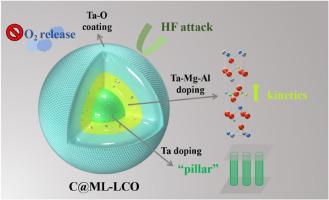A modification strategy for 4.6V LiCoO2: Uniform nano-coating and multi-level structure via high-temperature calcination
IF 7.9
2区 工程技术
Q1 CHEMISTRY, PHYSICAL
引用次数: 0
Abstract
Increasing the charge cut-off voltage is an effective means to boost the energy density of LiCoO2. However, high voltage induces severe interfacial side reactions and degradation of the layered structure in LiCoO2. The erosion of the interface by the by-product HF exacerbates this process, leading to battery failure. This study proposes suppressing the agglomeration of surface nano-coatings through applying a carbon source in combination with high-temperature calcination and forming a spinel-like transition layer to prevent the shedding of the nano-coating. Consequently, a multi-level modified structure comprising a Ta-O rock-salt phase nano-coating and Ta-Mg-Al gradient co-doped spinel phase is constructed. The uniformly coated Ta-O nano-coating serves as a physical barrier to effectively resist interfacial side reactions and HF corrosion. Additionally, Ta-Mg-Al co-doping that inhibits harmful phase transitions also enhances interfacial transport kinetics. The Ta element doped in the bulk phase inhibits the harmful H1-3 phase transition and stabilizes lattice oxygen. Therefore, the modified LiCoO2 exhibits excellent electrochemical performance at 4.6 V, with a capacity retention rate of 92.8 % after 100 cycles at 0.5C and a discharge specific capacity of 143.0 m h g−1 at 10 C. This work provides new ideas for the optimization of lithium-ion batteries.

4.6V LiCoO2的高温煅烧改性策略:均匀纳米涂层和多层结构
提高充电截止电压是提高LiCoO2能量密度的有效手段。然而,高电压会引起严重的界面副反应和层状结构的降解。副产品HF对界面的侵蚀加剧了这一过程,导致电池失效。本研究提出通过碳源与高温煅烧相结合,形成尖晶石样过渡层,抑制表面纳米涂层的团聚,防止纳米涂层脱落。因此,构建了由Ta-O岩盐相纳米涂层和Ta-Mg-Al梯度共掺杂尖晶石相组成的多层修饰结构。均匀涂覆的Ta-O纳米涂层可作为物理屏障,有效地抵抗界面副反应和HF腐蚀。此外,Ta-Mg-Al共掺杂抑制了有害的相变,也增强了界面传输动力学。体相中掺入Ta元素抑制了有害的H1-3相转变,稳定了晶格氧。因此,改性LiCoO2在4.6 V下表现出优异的电化学性能,在0.5C下循环100次后的容量保持率为92.8%,在10 c下的放电比容量为143.0 m h g−1,这为锂离子电池的优化提供了新的思路。
本文章由计算机程序翻译,如有差异,请以英文原文为准。
求助全文
约1分钟内获得全文
求助全文
来源期刊

Journal of Power Sources
工程技术-电化学
CiteScore
16.40
自引率
6.50%
发文量
1249
审稿时长
36 days
期刊介绍:
The Journal of Power Sources is a publication catering to researchers and technologists interested in various aspects of the science, technology, and applications of electrochemical power sources. It covers original research and reviews on primary and secondary batteries, fuel cells, supercapacitors, and photo-electrochemical cells.
Topics considered include the research, development and applications of nanomaterials and novel componentry for these devices. Examples of applications of these electrochemical power sources include:
• Portable electronics
• Electric and Hybrid Electric Vehicles
• Uninterruptible Power Supply (UPS) systems
• Storage of renewable energy
• Satellites and deep space probes
• Boats and ships, drones and aircrafts
• Wearable energy storage systems
 求助内容:
求助内容: 应助结果提醒方式:
应助结果提醒方式:


